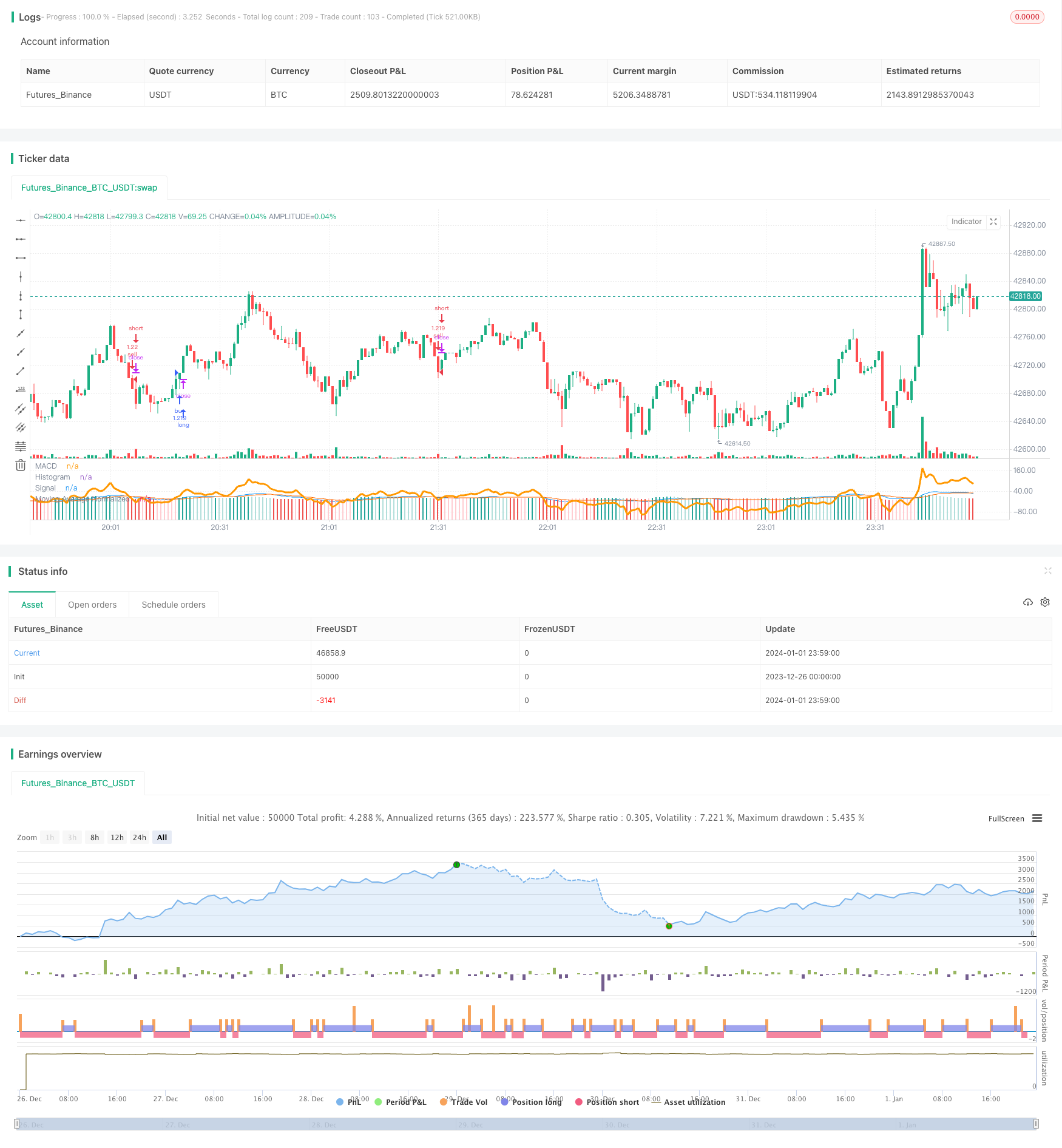MACD 200 Day Moving Average Crossover Trading Strategy
Author: ChaoZhang, Date: 2024-01-03 11:50:56Tags:

Overview
This trading strategy is a quantitative strategy based on the MACD indicator’s 200-day moving average crossover operation. It combines the dual functions of the MACD indicator to judge market buy and sell signals and the 200-day moving average to judge market trends, aiming to discover more precise entry and exit timing.
Strategy Principle
There are two key points to this strategy:
-
MACD indicator’s fast and slow line crossovers generate buy and sell signals. When the fast line breaks through the slow line upward, a buy signal is generated. When the fast line breaks through the slow line downward, a sell signal is generated.
-
The 200-day moving average judges the overall market trend. Prices above the 200-day moving average indicate a bull market, and below indicate a bear market. Buy signals are only acted upon in a bull market, and sell signals only in a bear market.
According to these two points, the specific trading rules of this strategy are:
When the MACD fast line breaks through the MACD slow line upward, the histogram is negative, and the price is above the 200-day moving average, a buy operation is made. When the MACD fast line breaks downward through the slow line, the histogram is positive, and the price is below the 200-day moving average, a sell operation is made.
Advantage Analysis
-
The dual confirmation improves the stability and success rate of the strategy. MACD judges the buy and sell signals, and the 200-day moving average judges the market trend. The dual confirmation can filter out some trading signals with greater uncertainty.
-
In a strongly trending market, this strategy can bring relatively high profits. Especially in a bull market, it can quickly capture price upside opportunities.
-
The MACD indicator is also relatively sensitive to getting out of consolidation phases. When the price ends a long period of consolidation and enters a trending phase, this strategy can quickly capture the new trend direction.
Risk Analysis
-
This strategy is quite sensitive to parameter settings. Improper MACD indicator parameter settings may cause false signals.
-
Near trend turning points, MACD signals tend to produce more errors. At this time, there may be a larger drawdown in the strategy’s profitability.
-
When prices are in a long period of consolidation, this strategy cannot determine a clear trend direction, which leads to increased fluctuation in profit/loss and longer drawdown times.
Optimization
-
Different parameter combinations can be tested to find MACD parameters that produce more accurate signals.
-
Consider adding confirmation from other technical indicators like RSI and KD to form a consensus of multiple indicators, thereby increasing the reliability of the strategy.
-
Set stop loss points to control maximum drawdown. Immediately stop loss when prices make a significant reversal, which can effectively avoid enlarging losses.
Conclusion
The MACD 200-day moving average crossover strategy combines the dual functions of trend judgment and trading signal judgment, which can effectively improve profitability probability. It is a relatively robust and reliable quantitative trading strategy. But this strategy also relies somewhat on parameters and market conditions. Continued optimization and testing can further enhance the stable profit-generating ability of the strategy.
/*backtest
start: 2023-12-26 00:00:00
end: 2024-01-02 00:00:00
period: 1m
basePeriod: 1m
exchanges: [{"eid":"Futures_Binance","currency":"BTC_USDT"}]
*/
// This source code is subject to the terms of the Mozilla Public License 2.0 at https://mozilla.org/MPL/2.0/
// © x11joe
//@version=4
//This strategy is based on a youtube strategy that suggested I do this...so I did!
strategy(title="MacD 200 Day Moving Average Signal Crossover Strategy", overlay=false, precision=2,commission_value=0.26, initial_capital=10000, currency=currency.USD, default_qty_type=strategy.percent_of_equity, default_qty_value=100)
// Getting inputs
fast_length = input(title="Fast Length", type=input.integer, defval=12)
slow_length = input(title="Slow Length", type=input.integer, defval=26)
src = input(title="Source", type=input.source, defval=close)
signal_length = input(title="Signal Smoothing", type=input.integer, minval = 1, maxval = 50, defval = 9)
sma_source = input(title="Simple MA(Oscillator)", type=input.bool, defval=false)
sma_signal = input(title="Simple MA(Signal Line)", type=input.bool, defval=false)
// Plot colors
col_grow_above = #26A69A
col_grow_below = #FFCDD2
col_fall_above = #B2DFDB
col_fall_below = #EF5350
col_macd = #0094ff
col_signal = #ff6a00
// Calculating
fast_ma = sma_source ? sma(src, fast_length) : ema(src, fast_length)
slow_ma = sma_source ? sma(src, slow_length) : ema(src, slow_length)
macd = fast_ma - slow_ma
signal = sma_signal ? sma(macd, signal_length) : ema(macd, signal_length)
hist = macd - signal
moving_avg_length = input(title="Moving Average Length", type=input.integer, defval=200)
moving_avg = sma(close,moving_avg_length)
moving_avg_normalized = close - moving_avg
plot(moving_avg_normalized, title="Moving Average Normalized", style=plot.style_line, color=color.orange,linewidth=3)
plot(hist, title="Histogram", style=plot.style_columns, color=(hist>=0 ? (hist[1] < hist ? col_grow_above : col_fall_above) : (hist[1] < hist ? col_grow_below : col_fall_below) ), transp=0 )
plot(macd, title="MACD", color=col_macd, transp=0)
plot(signal, title="Signal", color=col_signal, transp=0)
if(macd>signal and macd<0 and close>moving_avg)
strategy.entry("buy",strategy.long)
if(close<moving_avg and macd<signal and macd>0)
strategy.entry("sell",strategy.short)
- The Gaussian Moving Average Trading Strategy
- Adaptive Kaufman Moving Average Trend Following Strategy
- Bandpass Filtering Trend Extraction Strategy
- Dual Reversal High-Low Strategy
- Heyping Moving Average Trend Strategy
- Long and Short Opening Strategy Based on Multi Timeframe Moving Average and MACD
- Momentum Indicator RSI Reversal Trading Strategy
- Double Bollinger Band Breakout Strategy
- Automatic Tracking Trend Strategy Based on T3 and ATR
- ATR Channel Breakout Trend-following Strategy
- Golden Cross Uptrend Tracking Strategy
- Dual EMA Crossover Oscillation Tracking Strategy
- Stiffness Breakthrough Strategy
- Sideways Breakthrough Oscillation Strategy
- Quantitative Trading Strategy Based on RSI Indicator and Engulfing Pattern
- Bollinger Bands ATR Trailing Stop Strategy
- Daily Breakout Strategy
- Signal-to-Noise Moving Average Trading Strategy Based on Quantitative Trading
- Momentum Crossover Moving Average and MACD Filter Heikin-Ashi Candlestick Strategy
- Strategy of Synthesis between Multiple Relative Strength Indicators